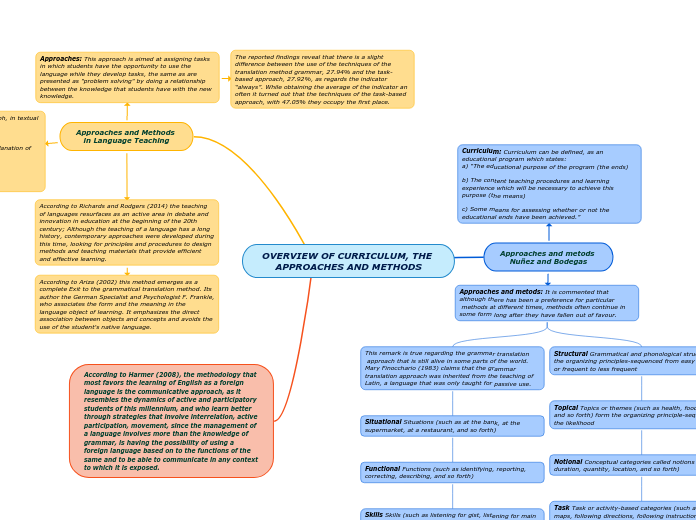OVERVIEW OF CURRICULUM, THE APPROACHES AND METHODS
Approaches and metods
Nuñez and Bodegas
Curriculum: Curriculum can be defined, as an educational program which states:
a) “The educational purpose of the program (the ends)
b) The content teaching procedures and learning experience which will be necessary to achieve this purpose (the means)
c) Some means for assessing whether or not the educational ends have been achieved.”
Approaches and metods: It is commented that although there has been a preference for particular
methods at different times, methods often continue in some form long after they have fallen out of favour.
This remark is true regarding the grammar translation
approach that is still alive in some parts of the world. Mary Finocchario (1983) claims that the grammar translation approach was inherited from the teaching of Latin, a language that was only taught for passive use.
Situational Situations (such as at the bank, at the supermarket, at a restaurant, and so forth)
Functional Functions (such as identifying, reporting, correcting, describing, and so forth)
Skills Skills (such as listening for gist, listening for main ideas, listening for inferences, scanning a reading passage for specific information, and so forth)
Structural Grammatical and phonological structures are the organizing principles-sequenced from easy to difficult or frequent to less frequent
Topical Topics or themes (such as health, food, clothing, and so forth) form the organizing principle-sequenced by the likelihood
Notional Conceptual categories called notions (such as duration, quantity, location, and so forth)
Task Task or activity-based categories (such as drawing maps, following directions, following instruction, and so forth)
Approaches and Methods
in Language Teaching
Methods: -Translation of a literary paragraph, in textual form.
-Reading comprehension questions.
-Use of synonyms and antonyms.
-Deductive application of rules, through explanation of these and their use.
-Activities to fill in the blanks.
-Vocabulary memorization activities.
-Use of words in sentences.
-Writing of Compositions.
Approaches: This approach is aimed at assigning tasks in which students have the opportunity to use the language while they develop tasks, the same as are presented as "problem solving" by doing a relationship between the knowledge that students have with the new knowledge.
The reported findings reveal that there is a slight difference between the use of the techniques of the translation method grammar, 27.94% and the task-based approach, 27.92%, as regards the indicator “always”. While obtaining the average of the indicator an often it turned out that the techniques of the task-based approach, with 47.05% they occupy the first place.
According to Richards and Rodgers (2014) the teaching of languages resurfaces as an active area in debate and innovation in education at the beginning of the 20th century; Although the teaching of a language has a long history, contemporary approaches were developed during this time, looking for principles and procedures to design methods and teaching materials that provide efficient and effective learning.
According to Ariza (2002) this method emerges as a complete Exit to the grammatical translation method. Its author the German Specialist and Psychologist F. Frankle, who associates the form and the meaning in the language object of learning. It emphasizes the direct association between objects and concepts and avoids the use of the student's native language.
